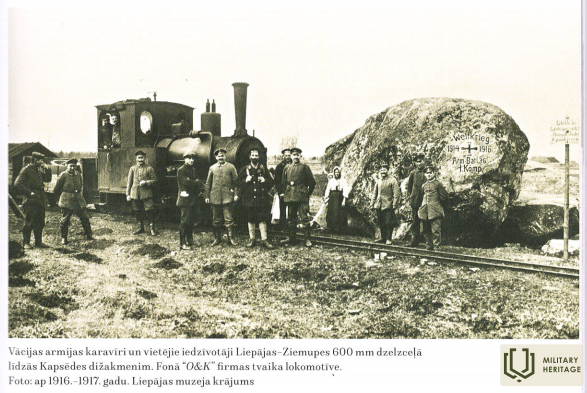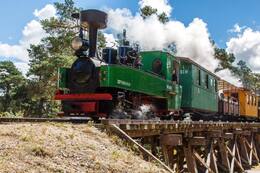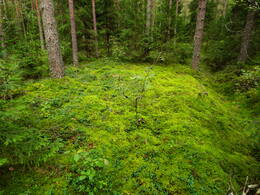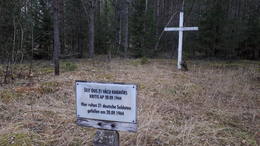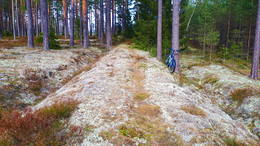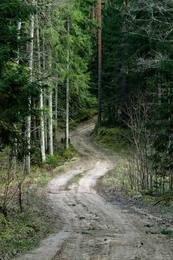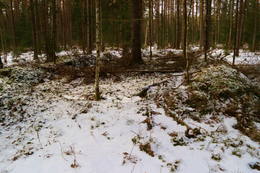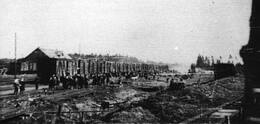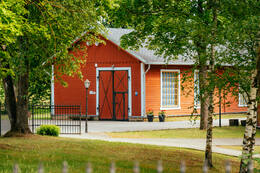Lauko geležinkeliai
Išplitusi 600 mm vėžės geležinkelių statyba sietina su I pasaulinio karo pradžia, kai 1916 metais Vokietijos kariuomenė okupuotoje Latvijos teritorijoje pradėjo tiesti kelis vadinamuosius „karo lauko“ (vok. „Heeresfeldbahn“) geležinkelius.
Atsižvelgiant į tuometines prastas kelių sąlygas, surenkamasis geležinkelis buvo tinkamiausia priemonė aprūpinti frontą karo lauke. Vokietijos kariuomenė turėjo specialius dalinius, kurie specializuojasi „lauko“ geležinkelių tiesimo ir eksploatavimo srityje. „Karo lauko“ geležinkelių įranga – bėgiai, vagonai ir lokomotyvai, kurie buvo specialiai sukurti kariuomenei, buvo standartizuoti, o tai supaprastino šių geležinkelių darbą.
Priekyje buvo pristatytos sumontuotos tiesios ir lenktos bėgių atkarpos, 5 metrų ilgio ant 10 geležinių pabėgių, kurios geromis oro sąlygomis leido per vieną dieną nutiesti kelis kilometrus „karo lauko“ geležinkelio. Šiuos geležinkelius būtų galima greitai nutiesti arba nugriauti ir pervežti į kitą fronto liniją.
Austrijos, JAV, Prancūzijos ir Didžiosios Britanijos kariuomenės taip pat turėjo panašius dalinius ir standartizuotą įrangą karo lauko geležinkeliams.
Daugiau informacijos šaltinių
Istorija – Ventspilio muziejus
Geležinkelio objektai – Ventspilio muziejus
geležinkelių transportas Latvijoje - Nacionalinė enciklopedija (enciklopedija.lv)
Susijusi laiko juosta
Susijusios vietos
Narrow gauge railway train “Mazbānītis” in Ventspils Seaside Open-air museum
In the Seaside Open-Air Museum in Ventspils you can take a ride on two narrow-gauge railway lines with the train ‘Mazbānītis’. The Circle line is 1.4 km and the Mountain line is 3 km. ‘Mazbānītis’ is the locomotive that transported passengers and cargo on 600 mm narrow-gauge railway tracks between 1916 and 1963. It is a legacy of military history from World War I that once played an important role in the cultural and economic development of northern Kurzeme by connecting settlements and providing new jobs.
Construction of a large 600 mm narrow-gauge railway network is largely associated with World War I, when the German Army in 1916 started the construction of several so-called military field railways (Heeresfeldbahn in German) in the occupied territory of Latvia. These railways could be quickly constructed, deconstructed and moved to another front line. The Latvian narrow-gauge railway network was used also during World War II. For almost 60 years the narrow-gauge railway was the only safe way of transporting passengers, various agricultural products and timber to cities in both winter and summer.
Former World War I narrow-gauge railway branch: “Banhoff – Bhf. Waldl. Salit" place
To the south and north of the Baldon - Tomes road, V4 (called "Düna Straße" on the First World War map) during the First World War, a light rail system was established to meet the needs of the front. To the south of the said road was “Bhf. (Bahnhoff) Waldl. (Waldlager – “Forest camp or warehouses”) Salit” – station “Forest camp/warehouses? The location of the railway line can be traced both on maps and LIDAR maps of different time and scale, as well as in nature. The mentioned railway section branches off from the modern Vecumnieku station (Bhf. Neugut Kurland) - Mercendarbe (Merzendorf) broad-gauge railway approximately one kilometer east of Gēdiņi houses (station - "Bahnhoff Gedeng"). The first kilometers of the railway line from the Gediņi station are nowadays covered by forest, and in order to explore the nature of the line, you need to take LIDAR maps and patience while wading along the overgrown, but still visible, nature embankment of the railway embankment. At least 20 deep, quadrangular pits (storage places?) can be seen in the nature on both sides of the railway line, by the adjacent road and in the dune wall (south of the road). For the next 1.3 km, the location of the railway line can be traced in nature as a nice, transparent forest road, which in places crosses small dune embankments with trenches in them. Further - for a length of 3.5 km, the location of the railway line coincides with the road built by Latvian State Forests, which, turning in a sharp curve to the northwest, the railway line continues to move in the northeast direction and after 0.3 km reaches the former station (Bhf. Waldl. Salit) site, which is clearly visible on the LIDAR map. Nothing from the station has been preserved in nature, but in the vicinity you can see many dug pits of various depths and shapes, and in the dune ramparts that surround the station site - the remains of trenches. In front of the mentioned station, a dune trench is visible where the railway line continues in a northerly direction. It crossed Silupi (Kausupi) near Sille houses (former station "Bhf. Sille), but near Podnieki houses it branched. The first branch went to the right to Berkava, and the second to the left to Vilku mountains and then returned to the broad gauge (1435 mm) at the Skarbe railway station.
Kaiser Dam (Kaiser - Damm)
The 8 km long road with this name, marked on the German army maps of the First World War, started at the former Kurland Denkmal, or later popularly known as the Woman's Monument, and ended at the former Auermann houses. Today, the northeast-southwest direction of the Keizerdambis can be walked or cycled along its entire length. Approximately 4 km long, it stretches as a forest-land (in some places - with large gravel fragments) road, 4 km - as a gravel road (coincides with the Abermans and Egles-Kaulupes roads built by the Latvian State Forests). The section between the Elges - Kaulupes road and the Abermani road is also called Mātīte stiga in LVM maps. In its middle part, Keizerdambis crosses a beautiful massif of inland dunes, in the vicinity of which wartime trenches and construction sites can be seen on LIDAR maps. A white wooden cross has been installed near the former Aurmaņi houses at the place where 21 soldiers of the German army were buried (fallen around 20.09.1944).
It is possible that the name of Ķeizardambja, which arose during the stay of the German army during the First World War, comes from the Kaiserdamm – a 50 m wide and 1680 m long street in Berlin, which was opened in 1906.
The site of the former barracks of the First World War
It is located in the forest 0.6 - 0.7 km south of the village of Latgali. The best idea of the territory can be obtained if it is studied in advance on LIDAR maps, because in nature the positions of trenches and other earth surface formations dug by people a century ago can be overlooked by the uninitiated. Judging by the remains of a brick oven and other signs visible in the excavations (done by someone else), German army barracks were located here. Next to the barracks, a narrow-gauge railway was built to supply the Daugava front line along the Great Kurfirsti dam from the modern Lāčplėš station along Birzgali and beyond. 0.5 km east of the barracks was the so-called Kurland Denkmal, but on the left bank of the Daugava in a 1.3 km radius around the barracks there were three reinforced concrete fire points (preserved to this day, but the remains of one are under water and appear only when HES water level has been reduced), but 0.6 km west of them there was a shooting range, of which nothing has been preserved in nature. Pits can be seen in nature around the shooting site - the remains of former buildings and fortifications. About 100-200 m southeast of the site of the former barracks, three to 30 m long, rectangular trenches (and smaller ones) are clearly visible in the nature, which were probably warehouses.
The first narrow-gauge railway line of the World War era: Lāčplēsis – Latgali
About 22 km long narrow-gauge railway line from the time of the First World War, which started at the present Lāčplēš (Jelgava - Krustpils railway line) railway station (formerly Bahnhoff Kerghof), surrounded Birzgali from the east, crossed the Nega river, then turned to the west, crossing twice modern Abermani road (connects Ķegum with Vecumnieku (P88) road) and then moved along Ķeizardambi (Kaiser – Damm) to the former Kurland Denkmal, where, judging by the visible LIDAR map (divides into three branches?), the terminus station was located. The Kurzeme monument was located 680 m southeast of the village of Latgali. The main purpose of the railway was to provide and support the front of the left bank of the Daugava with the necessary supplies. During the First World War, there were barracks and warehouses of the German army near Ķizerdambje, on the left bank of the Daugava near Puduriem (0.6 km) and Podnieki (0.9 km) there were a total of three concrete fire points of the German army. Today, the location of a railway line can be tracked by LIDAR maps in nature. Certain parts of it are also clearly visible in nature, especially when the vegetation has not matured. The best time to go on an expedition is early spring or winter when there is no snow.
Prince Leopold Straße (Prinz – Leopold Straße)
The name of the place (road) during the First World War - "Prinz - Leopold Straße" - Prince Leopold's road. About 7 km long historical forest road or the place that started at the junction of Große Kurfürsten Damm and Kaiser Damm near the so-called Kurland Denkmal and winds through the forest towards Birzgale, connecting with the First World wartime narrow-gauge railway line: Lāčplēsis – Latgali. To the west of the road and about 2 km south of the site of the Kurland Denkmal is a First World War shooting range. Today, the Prince Leopold Road can be walked, cycled and driven (under suitable conditions). The road crosses Konupīti and the Nega tributary.
It is thought that the soldiers of the German army, staying for a long time on the front of the left bank of the Daugava, named this road after the Bavarian Prince Leopold (1846 - 1930), who led the German and Austro-Hungarian forces on the Eastern Front during the First World War.
First World War narrow-gauge railway line: Lāčplēsis - Vitkopi
The place of a 9 km long railway line, the beginning of which was at the current Läčplėš railway station (Bhf. Kerghof), and the end point - the place at the modern Lake Witkop (Bhf. Witkop). There were two more stations on the line: Bhf. Sillesemnek (Silenieki) and Bhf. Hasenheide. In nature and on the LIDAR map, north of Vitkop Lake (artificial reservoir), > 100 pits of various sizes and shapes are visible - presumably the "traces" of buildings, warehouses, etc. infrastructure from the First World War. To the south of the lake is the cemetery of the Witkop brothers. With the support of this railway line, the needs of the German army front on the left bank of the Daugava were provided during the First World War.
Taurkalne German army warehouses
Approximately 0.7 x 0.4 km large, wooded area north of the Jelgava - Krustpils railway and east of Taurkalne village, crossed by a forest road and trails. In nature and on LIDAR maps, about 100 quadrangular pits dug in straight rows with small ramparts and an exit are visible. According to Daumantas Krastiņas: "German warehouses are partially buried in the ground. The superstructure has a wooden or corrugated tin roof. Here some longer ones with entrances at either end were staff barracks. Next to it was a normal and rural railway station of the First World War, but during the Second World War the superstructure could be restored and used for the supply of the Nord group, using the nearby Daugava bridge. If ammunition was stored during the Second World War, then they managed to use it up to the release in the air on 19 or 20.09.1944." Local residents' stories about the German army's underground passages and a bunker buried in one of the nearby hills, as well as a German train that "went underground under the mountain" have been preserved.
The former railway of the First World War: Vecumnieki - Mercendarbe
In 1916, when the front line of the German army had strengthened and stabilized along the left bank of the Daugava, on March 15, a decision was made to build a 25 km railway line from Vecumnieki (Bhf. Neugut Kurland) to Baldone (station: Mercendarbe - Merzendorf) for the supply needs of the front. in length with a track width of 1435 mm. On March 30, around 5,000 workers started work and by May 1, the line was built to Skarbe station, and on May 6 – to Mercendarbe. The order of stations from south to north was as follows: Neugut Kurland, Nougut Nord, Birsemnek, Gedeng, Skarbe, Merzendorf. In the largest of the stations - Skarbe, cargo was transshipped, from where it was further transported to the front by horse transport. As early as 1921 transported logs and firewood along the railway line until it was demolished in 1925. The location of the railway line is very different in different sections - in some places roads of different importance pass along it, in some places as a clearly visible embankment crosses forest massifs. There are places that are difficult to pass during the growing season.
At the former Gediņu station ("Bahnhoff Gedeng"), a narrow-gauge railway branched off in the northeast direction, the tracks of which continued towards the Daugava. It crossed Silupi (Kausupi) near Sille houses (former station "Bhf. Sille), but near Podnieki houses it branched. The first branch went to the right to Berkava, and the second to the left to Vilku mountains and then returned to the broad gauge (1435 mm) at the Skarbe railway station.
1917 in September, the Germans built another narrow-gauge railway line (track width - 600 mm) from Mercendarbe and Skarbe to the Daugava, where they built a pontoon bridge and on October 1 opened traffic all the way to Ikškile. On the 4th of December, the said bridge was taken away with the sledgehammers.
Mazbānīš trail in North Kurzeme
Mazbānīti is the name given to a train in North Kurzeme that transported passengers and cargo along 600 mm wide narrow-gauge railway tracks between 1916 and 1963. It is a legacy of military history from the First World War, which once played an important role in the cultural and economic prosperity of the whole of Northern Kurzeme, but especially of the Libyan fishing villages, providing connections between settlements, providing jobs.
The nature trail leads from Mazirbe to Sīkraga along the path of the former Stende - Ventspils narrow-gauge railway, or as the locals say - the path of Mazbānīš. The construction of the railway started in 1916 and it served until 1963. The narrow-gauge railway line connected the port city of Ventspils with the coastal fishing villages of Dundas and the major railway hub of Stande, thus contributing to the region's economic and cultural boom between the First and Second World Wars.
During the times of the Soviet Union, the coast was a "Closed Zone", therefore coastal villages were economically isolated and their population decreased, the presence of newly built secret army facilities also contributed to the fact that in the sixties of the last century, railway traffic was stopped.
The trail has a small loop of 15 km and a large loop of 19 km.
The GPX map is available here:
https://www.kurzemesregions.lv/projekti/turisms/unigreen/dabas-takas/mazbanisa-dabas-taka/
Stende railway station in narrow gauge railway network and the memorial stone for deportations
The railway line Ventspils - Mazirbe, as well as the Stende - Dundaga extension to Mazirbe with a branch to Pitrags, were intended only for strategic military needs. During the construction of these lines, and afterwards, all civilians were evacuated from the region. The main task of the military railways in the Irbe Strait area was to provide the German army's coastal defence positions with guns and ammunition.
These military-only military railways also connected the three most important lighthouses, located in Oviši, Mikeltornis and Šlītere.
Nevertheless, passenger transport was also provided as early as the years of World War I.
A memorial stone (1989) to the deported Latvians of 1941 and 1949 is located at the Stende railway station.
On 30 October 1919, Stende railway station was occupied by Bermont troops. On 17 November, soldiers of the Latvian army led by K. Šnēbergs attacked the station, driving away a wagon with weapons, war materials and grain. 6 soldiers were awarded the Order of the Order for these battles: K. Bumovskis (1891-1976), P. Strautiņš (1883-1969), R. Plotnieks (1891-1965), E. Jansons (1894-1977).
Viesytės muziejus „Sėlija“ (Sēlija)
Viesytės muziejų sudaro keli skyriai: Sėlijos namai, kuriuose įrengta Sėlijos kultūros istorijos ekspozicija, Turizmo informa cijos punktas, veikiantis buvusiame geležinkelio kontoros pastate, buvusi Viesytės depo lokomotyvų remonto dirb tuvė, Amatų centras ir Sėlijos siaurojo geležinkelio istorijos ekspozicija, įrengta buvusioje geležinkelio vagonų remonto dirbtuvėje. Žinomiausia Viesytės muziejaus dalis – Mažo jo Traukinuko parkas, įkurtas buvusio Viesytės geležinkelio depo teritorijoje.
Siaurąjį geležinkelį, iš pradžių skirtą kariniams kroviniams vežti, 1915–1916 m. nutiesė vokiečių kariuomenė, tačiau po Pirmojo pasaulinio karo jis buvo pritaikytas keleivių per vežimams. Muziejuje galima pamatyti 1918 m. bendrovės „Schwarzkopff“ pagamintą garvežį, 1916 m. pagamintą tarnybinį vagoną, krovininį vagoną, medienos transporta vimo platformą, vagonėlį, dreziną ir susipažinti su Sėlijos siau rojo geležinkelio istorija. Muziejui taip pat priklauso septyni istoriniai stoties pastatai. Mažojo Traukinuko parke laukiami lankytojai su vaikais. Netoli nuo minėto parko, istorinėje Viesytės stoties aikštėje yra išlikusi vienintelė Latvijoje siaurojo geležinkelio atkarpa su senoviniu vandens siurbliu. Prie stoties aikštės stovi keli istori niai pastatai: geležinkelio krovinių sandėlis, kultūros namai, keleivių stoties pastatas ir ambulatorija
Vecumnieki Railway Station
Vecumnieki railway station is located south of the village of Vecumnieki.
Vecumnieki railway station was built in 1904 as a station on the Ventspils-Moscow railway line. Initially, it was called “Neugut” (during the German occupation in 1916/1917, it was called “Neugut Kurland”). It gained greater importance during the First World War, when a European-wide railway branch was built from it. In 1916, when the German army's front line had strengthened and stabilized along the left bank of the Daugava, on March 15, a decision was made to build a 25 km railway line with a track gauge of 1435 mm from Vecumnieki to Baldone (station: Mercendarbe - Merzendorf) for the needs of supplying the front. On March 30, about 5,000 workers began work, and by May 1, the line had been built to Skarbe station, and by May 6, to Mercendarbe. The sequence of stations from south to north was as follows: Neugut Kurland, Nougut Nord, Birsemnek, Gedeng, Skarbe, Merzendorf. At the largest of the stations, Skarbe, cargo was transshipped, from where it was transported to the front by horse-drawn transport. This railway existed for only a few years, as late as 1921, logs and firewood were transported along the railway line, until it was demolished in 1925. The location of the railway line is very different in different sections - in places it is crossed by roads of various importance, in places, as the embankment is clearly visible, it crosses forest massifs. There are places that are difficult to pass during the vegetation period.
At the former Gediņi station ("Bahnhoff Gedeng"), a narrow-gauge railway branched off in a northeasterly direction, the tracks of which continued towards the Daugava. At the Sila house it crossed Silupi (Kausupi) (former station "Bhf. Sille"), but at the Podnieki house it branched off. The first branch went to the right to Berkavas, and the second to the left to Vilki mountains and then returned to the broad-gauge (1435 mm) railway at the Skarbe station.
In September 1917, the Germans built another narrow-gauge railway line (gauge of 600 mm) from Mercendarbe and Skarbe to the Daugava, where they built a pontoon bridge and opened traffic all the way to Ikšķile on October 1. The flood of December 4 washed away the aforementioned bridge.
Since 1919, the station has been called Vecmuiža. In 1926, a stone building (architect J. Neijs) was built on the site of the wooden station building destroyed in the war. In 1940, the station was renamed Vecumnieki. In 2000, passenger train traffic was closed on the Jelgava—Krustpils line; currently, this line is used only for freight train traffic.
Susijusi istorija
Svarbi Stendės stoties vieta Karaliaus geležinkelių tinkle
Pagrindinė mūšio lauko geležinkelių užduotis Irbes sąsiaurio rajone buvo aprūpinti vokiečių kariuomenės pakrančių gynybos pozicijas pabūklais ir amunicija.
600 mm siaurieji geležinkeliai Sēlijoje
Dažnai sakoma, kad karas yra visų dalykų tėvas, ir taip buvo Latvijos kaimo geležinkelių atveju. Bet kuriai armijai, nesvarbu, ar ji puola, ar ginasi, karui vykdyti reikia didelių išteklių. Kai 1915 m. Vokietijos kariuomenė įžengė į Latvijos teritoriją, susidūrė su logistiniais iššūkiais. Iki 1915 metų pabaigos frontas stabilizavosi palei Dauguvos liniją. Istoriškai Sēlijos teritorija buvo mažo gyventojų tankumo, todėl nebuvo išplitusio transporto kelių tinklo.




